FORD F250 2003 Owners Manual
Manufacturer: FORD, Model Year: 2003, Model line: F250, Model: FORD F250 2003Pages: 280, PDF Size: 3.73 MB
Page 161 of 280
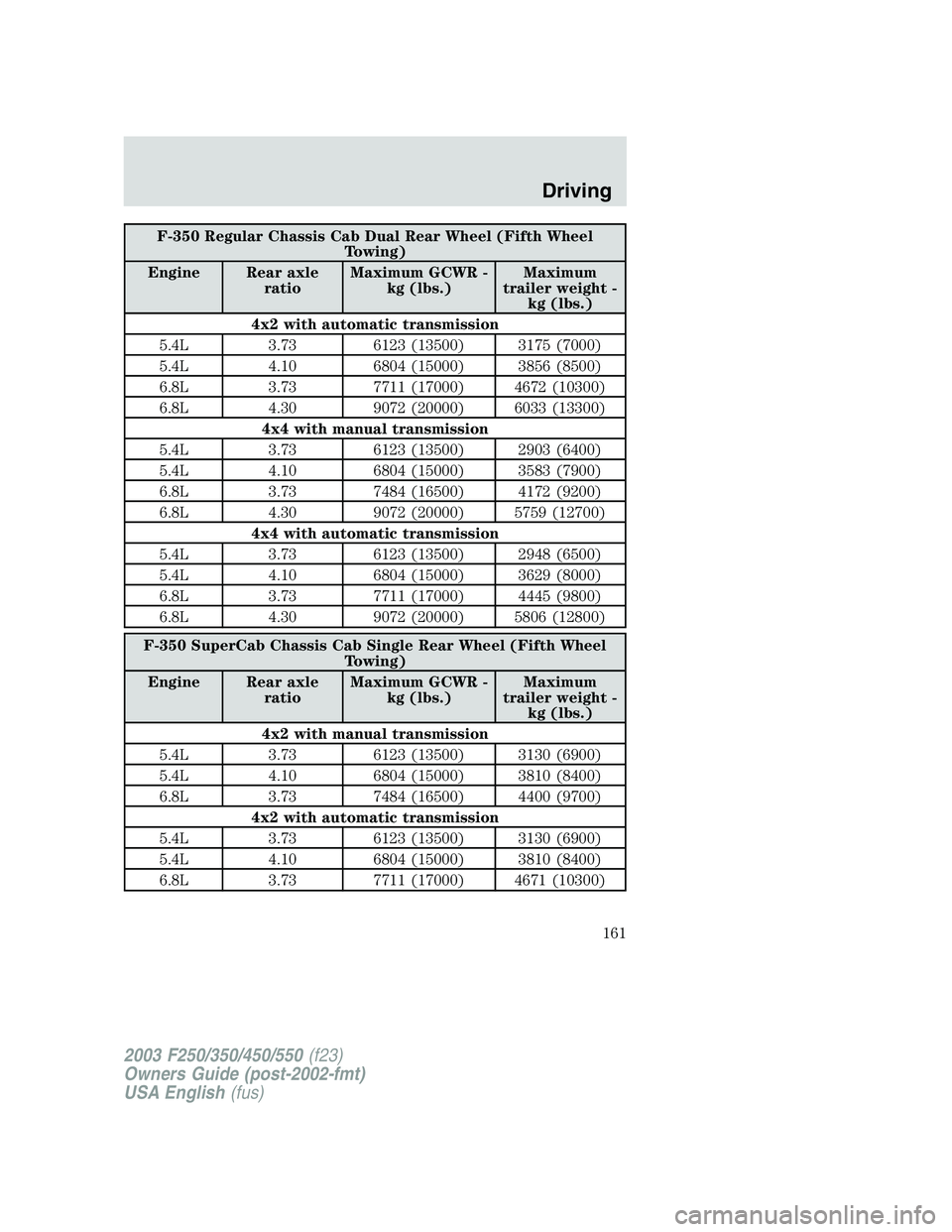
F-350 Regular Chassis Cab Dual Rear Wheel (Fifth Wheel
Towing)
Engine Rear axle
ratioMaximum GCWR -
kg (lbs.)Maximum
trailer weight -
kg (lbs.)
4x2 with automatic transmission
5.4L 3.73 6123 (13500) 3175 (7000)
5.4L 4.10 6804 (15000) 3856 (8500)
6.8L 3.73 7711 (17000) 4672 (10300)
6.8L 4.30 9072 (20000) 6033 (13300)
4x4 with manual transmission
5.4L 3.73 6123 (13500) 2903 (6400)
5.4L 4.10 6804 (15000) 3583 (7900)
6.8L 3.73 7484 (16500) 4172 (9200)
6.8L 4.30 9072 (20000) 5759 (12700)
4x4 with automatic transmission
5.4L 3.73 6123 (13500) 2948 (6500)
5.4L 4.10 6804 (15000) 3629 (8000)
6.8L 3.73 7711 (17000) 4445 (9800)
6.8L 4.30 9072 (20000) 5806 (12800)
F-350 SuperCab Chassis Cab Single Rear Wheel (Fifth Wheel
Towing)
Engine Rear axle
ratioMaximum GCWR -
kg (lbs.)Maximum
trailer weight -
kg (lbs.)
4x2 with manual transmission
5.4L 3.73 6123 (13500) 3130 (6900)
5.4L 4.10 6804 (15000) 3810 (8400)
6.8L 3.73 7484 (16500) 4400 (9700)
4x2 with automatic transmission
5.4L 3.73 6123 (13500) 3130 (6900)
5.4L 4.10 6804 (15000) 3810 (8400)
6.8L 3.73 7711 (17000) 4671 (10300)
2003 F250/350/450/550(f23)
Owners Guide (post-2002-fmt)
USA English(fus)
Driving
161
Page 162 of 280

F-350 SuperCab Chassis Cab Single Rear Wheel (Fifth Wheel
Towing)
Engine Rear axle
ratioMaximum GCWR -
kg (lbs.)Maximum
trailer weight -
kg (lbs.)
4x4 with manual transmission
5.4L 3.73 6123 (13500) 2903 (6400)
5.4L 4.10 6804 (15000) 3583 (7900)
6.8L 3.73 7484 (16500) 4218 (9300)
4x4 with automatic transmission
5.4L 3.73 6123 (13500) 2948 (6500)
5.4L 4.10 6804 (15000) 3629 (8000)
6.8L 3.73 7711 (17000) 4445 (9800)
F-350 SuperCab Chassis Cab Dual Rear Wheel (Fifth Wheel
Towing)
Engine Rear axle
ratioMaximum GCWR -
kg (lbs.)Maximum
trailer weight -
kg (lbs.)
4x2 with manual transmission
6.8L 3.73 7484 (16500) 4264 (9400)
6.8L 4.30 9072 (20000) 5851 (12900)
4x2 with automatic transmission
6.8L 3.73 7711 (17000) 4491 (9900)
6.8L 4.30 9072 (20000) 5851 (12900)
4x4 with manual transmission
6.8L 3.73 7484 (16500) 4082 (9000)
6.8L 4.30 9072 (20000) 5670 (12500)
4x4 with automatic transmission
6.8L 3.73 7711 (17000) 4309 (9500)
6.8L 4.30 9072 (20000) 5670 (12500)
2003 F250/350/450/550(f23)
Owners Guide (post-2002-fmt)
USA English(fus)
Driving
162
Page 163 of 280
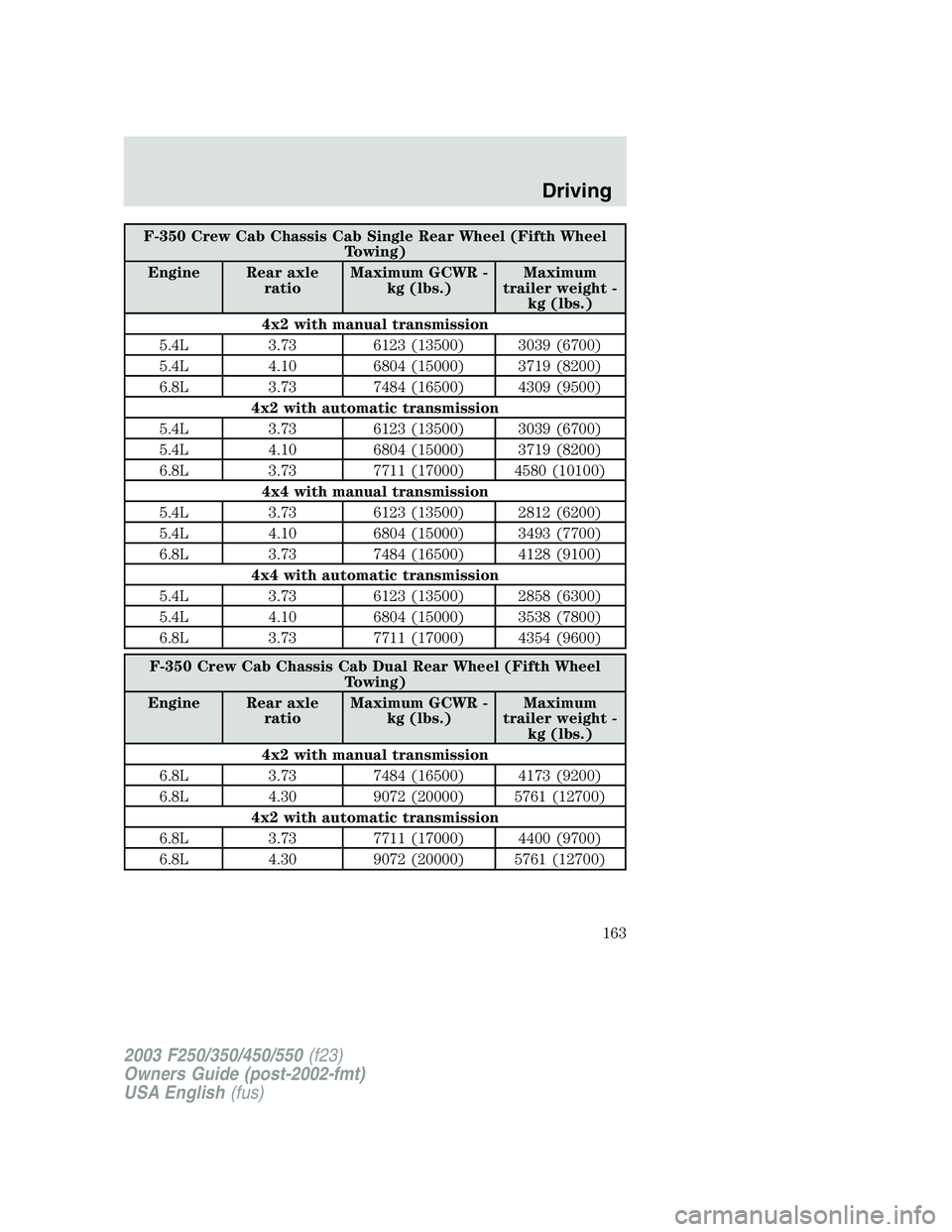
F-350 Crew Cab Chassis Cab Single Rear Wheel (Fifth Wheel
Towing)
Engine Rear axle
ratioMaximum GCWR -
kg (lbs.)Maximum
trailer weight -
kg (lbs.)
4x2 with manual transmission
5.4L 3.73 6123 (13500) 3039 (6700)
5.4L 4.10 6804 (15000) 3719 (8200)
6.8L 3.73 7484 (16500) 4309 (9500)
4x2 with automatic transmission
5.4L 3.73 6123 (13500) 3039 (6700)
5.4L 4.10 6804 (15000) 3719 (8200)
6.8L 3.73 7711 (17000) 4580 (10100)
4x4 with manual transmission
5.4L 3.73 6123 (13500) 2812 (6200)
5.4L 4.10 6804 (15000) 3493 (7700)
6.8L 3.73 7484 (16500) 4128 (9100)
4x4 with automatic transmission
5.4L 3.73 6123 (13500) 2858 (6300)
5.4L 4.10 6804 (15000) 3538 (7800)
6.8L 3.73 7711 (17000) 4354 (9600)
F-350 Crew Cab Chassis Cab Dual Rear Wheel (Fifth Wheel
Towing)
Engine Rear axle
ratioMaximum GCWR -
kg (lbs.)Maximum
trailer weight -
kg (lbs.)
4x2 with manual transmission
6.8L 3.73 7484 (16500) 4173 (9200)
6.8L 4.30 9072 (20000) 5761 (12700)
4x2 with automatic transmission
6.8L 3.73 7711 (17000) 4400 (9700)
6.8L 4.30 9072 (20000) 5761 (12700)
2003 F250/350/450/550(f23)
Owners Guide (post-2002-fmt)
USA English(fus)
Driving
163
Page 164 of 280
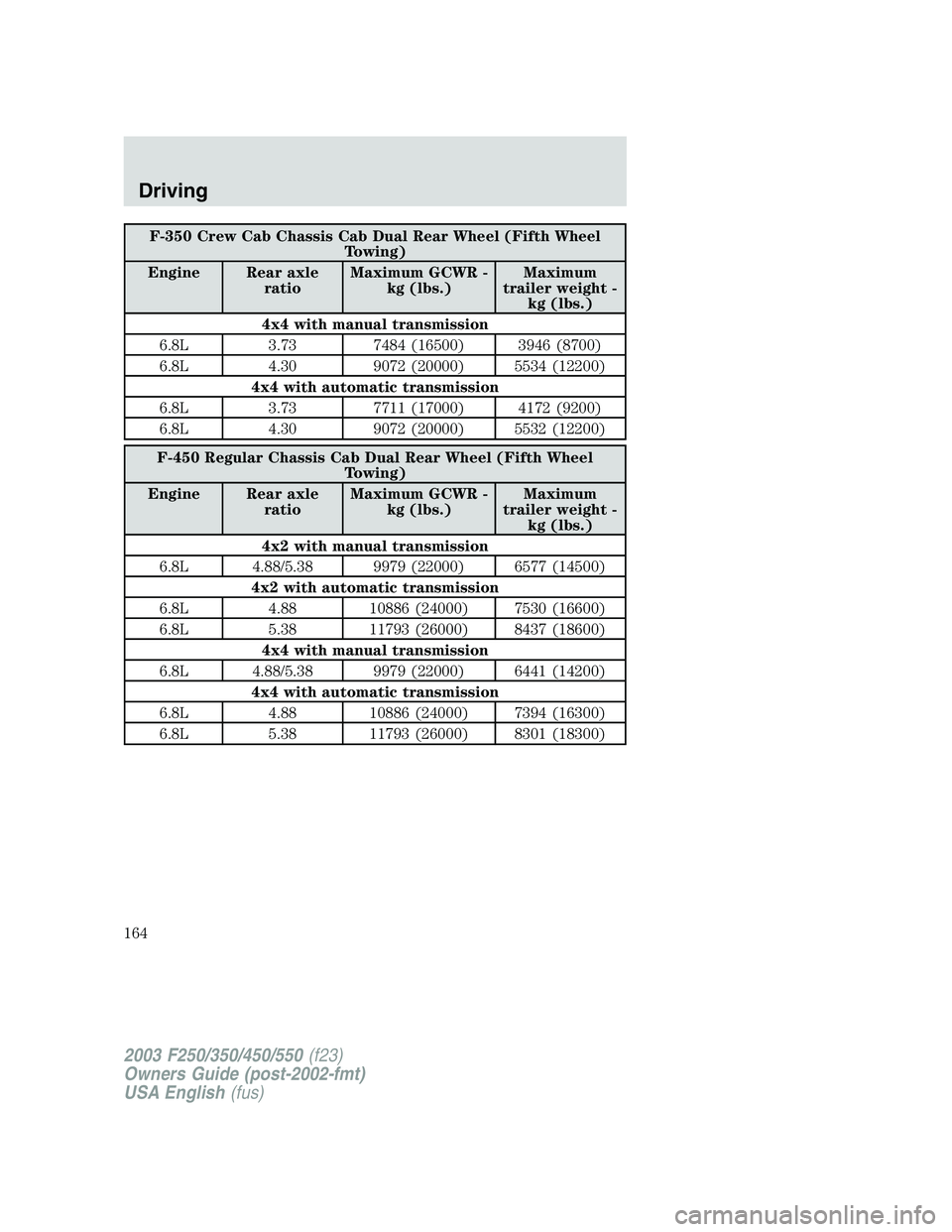
F-350 Crew Cab Chassis Cab Dual Rear Wheel (Fifth Wheel
Towing)
Engine Rear axle
ratioMaximum GCWR -
kg (lbs.)Maximum
trailer weight -
kg (lbs.)
4x4 with manual transmission
6.8L 3.73 7484 (16500) 3946 (8700)
6.8L 4.30 9072 (20000) 5534 (12200)
4x4 with automatic transmission
6.8L 3.73 7711 (17000) 4172 (9200)
6.8L 4.30 9072 (20000) 5532 (12200)
F-450 Regular Chassis Cab Dual Rear Wheel (Fifth Wheel
Towing)
Engine Rear axle
ratioMaximum GCWR -
kg (lbs.)Maximum
trailer weight -
kg (lbs.)
4x2 with manual transmission
6.8L 4.88/5.38 9979 (22000) 6577 (14500)
4x2 with automatic transmission
6.8L 4.88 10886 (24000) 7530 (16600)
6.8L 5.38 11793 (26000) 8437 (18600)
4x4 with manual transmission
6.8L 4.88/5.38 9979 (22000) 6441 (14200)
4x4 with automatic transmission
6.8L 4.88 10886 (24000) 7394 (16300)
6.8L 5.38 11793 (26000) 8301 (18300)
2003 F250/350/450/550(f23)
Owners Guide (post-2002-fmt)
USA English(fus)
Driving
164
Page 165 of 280
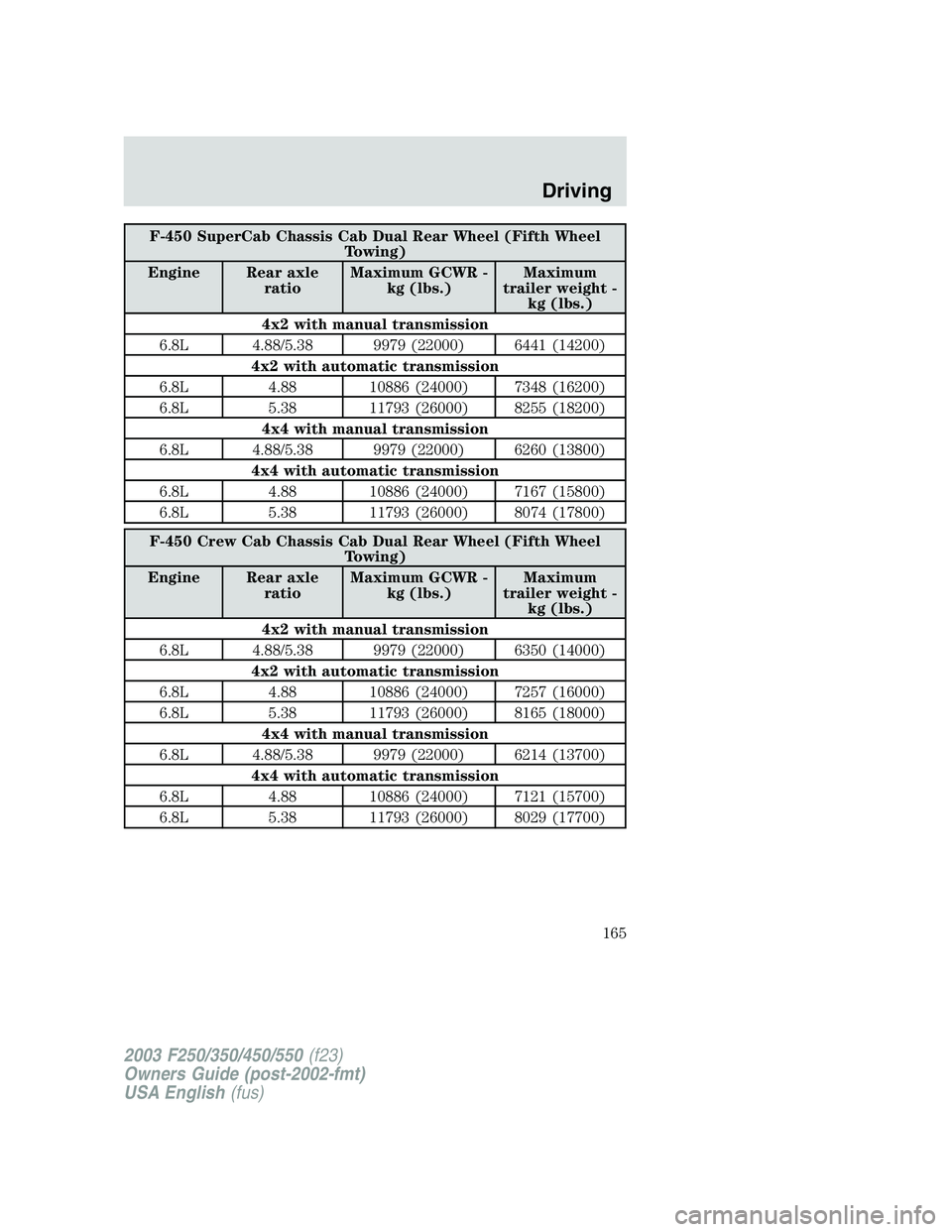
F-450 SuperCab Chassis Cab Dual Rear Wheel (Fifth Wheel
Towing)
Engine Rear axle
ratioMaximum GCWR -
kg (lbs.)Maximum
trailer weight -
kg (lbs.)
4x2 with manual transmission
6.8L 4.88/5.38 9979 (22000) 6441 (14200)
4x2 with automatic transmission
6.8L 4.88 10886 (24000) 7348 (16200)
6.8L 5.38 11793 (26000) 8255 (18200)
4x4 with manual transmission
6.8L 4.88/5.38 9979 (22000) 6260 (13800)
4x4 with automatic transmission
6.8L 4.88 10886 (24000) 7167 (15800)
6.8L 5.38 11793 (26000) 8074 (17800)
F-450 Crew Cab Chassis Cab Dual Rear Wheel (Fifth Wheel
Towing)
Engine Rear axle
ratioMaximum GCWR -
kg (lbs.)Maximum
trailer weight -
kg (lbs.)
4x2 with manual transmission
6.8L 4.88/5.38 9979 (22000) 6350 (14000)
4x2 with automatic transmission
6.8L 4.88 10886 (24000) 7257 (16000)
6.8L 5.38 11793 (26000) 8165 (18000)
4x4 with manual transmission
6.8L 4.88/5.38 9979 (22000) 6214 (13700)
4x4 with automatic transmission
6.8L 4.88 10886 (24000) 7121 (15700)
6.8L 5.38 11793 (26000) 8029 (17700)
2003 F250/350/450/550(f23)
Owners Guide (post-2002-fmt)
USA English(fus)
Driving
165
Page 166 of 280
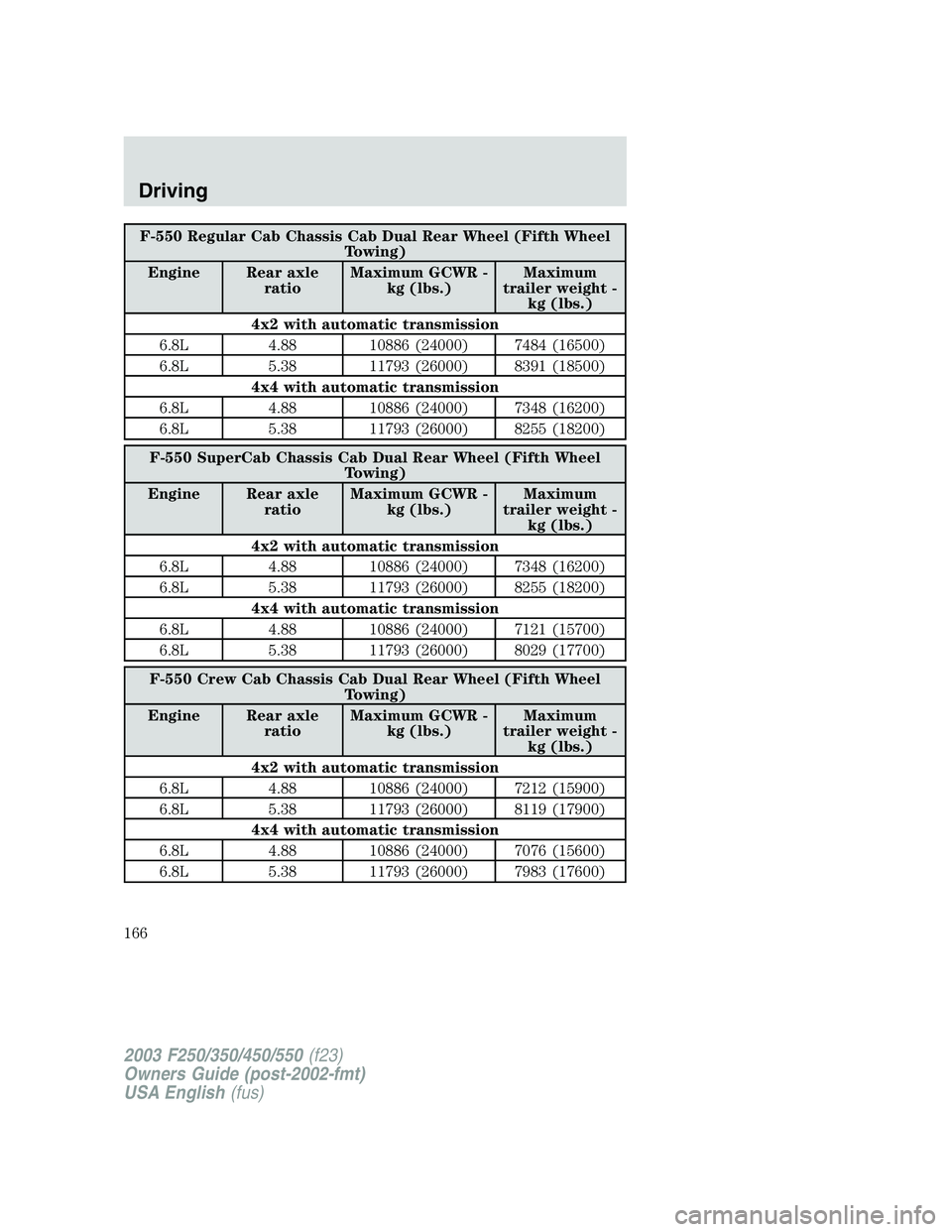
F-550 Regular Cab Chassis Cab Dual Rear Wheel (Fifth Wheel
Towing)
Engine Rear axle
ratioMaximum GCWR -
kg (lbs.)Maximum
trailer weight -
kg (lbs.)
4x2 with automatic transmission
6.8L 4.88 10886 (24000) 7484 (16500)
6.8L 5.38 11793 (26000) 8391 (18500)
4x4 with automatic transmission
6.8L 4.88 10886 (24000) 7348 (16200)
6.8L 5.38 11793 (26000) 8255 (18200)
F-550 SuperCab Chassis Cab Dual Rear Wheel (Fifth Wheel
Towing)
Engine Rear axle
ratioMaximum GCWR -
kg (lbs.)Maximum
trailer weight -
kg (lbs.)
4x2 with automatic transmission
6.8L 4.88 10886 (24000) 7348 (16200)
6.8L 5.38 11793 (26000) 8255 (18200)
4x4 with automatic transmission
6.8L 4.88 10886 (24000) 7121 (15700)
6.8L 5.38 11793 (26000) 8029 (17700)
F-550 Crew Cab Chassis Cab Dual Rear Wheel (Fifth Wheel
Towing)
Engine Rear axle
ratioMaximum GCWR -
kg (lbs.)Maximum
trailer weight -
kg (lbs.)
4x2 with automatic transmission
6.8L 4.88 10886 (24000) 7212 (15900)
6.8L 5.38 11793 (26000) 8119 (17900)
4x4 with automatic transmission
6.8L 4.88 10886 (24000) 7076 (15600)
6.8L 5.38 11793 (26000) 7983 (17600)
2003 F250/350/450/550(f23)
Owners Guide (post-2002-fmt)
USA English(fus)
Driving
166
Page 167 of 280
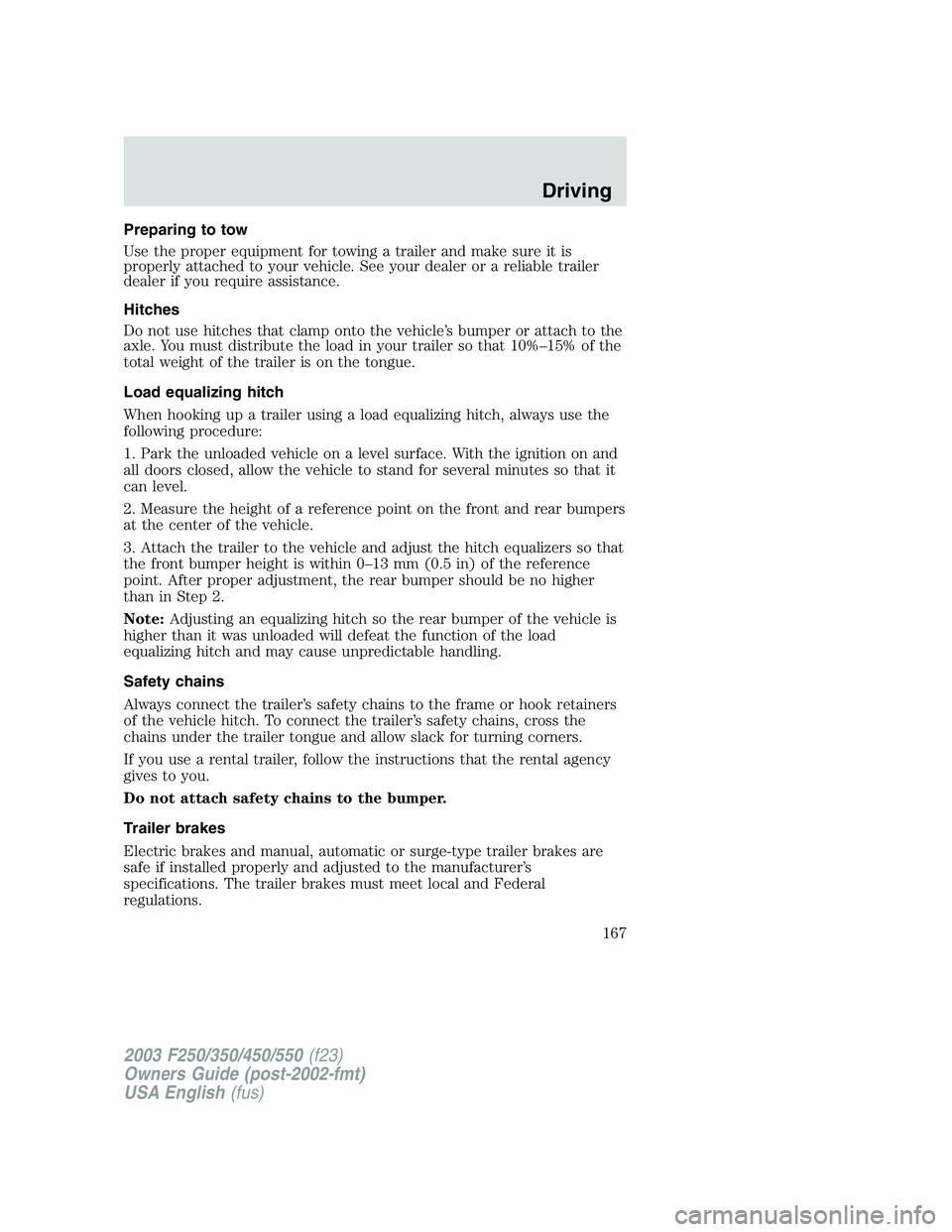
Preparing to tow
Use the proper equipment for towing a trailer and make sure it is
properly attached to your vehicle. See your dealer or a reliable trailer
dealer if you require assistance.
Hitches
Do not use hitches that clamp onto the vehicle’s bumper or attach to the
axle. You must distribute the load in your trailer so that 10%–15% of the
total weight of the trailer is on the tongue.
Load equalizing hitch
When hooking up a trailer using a load equalizing hitch, always use the
following procedure:
1. Park the unloaded vehicle on a level surface. With the ignition on and
all doors closed, allow the vehicle to stand for several minutes so that it
can level.
2. Measure the height of a reference point on the front and rear bumpers
at the center of the vehicle.
3. Attach the trailer to the vehicle and adjust the hitch equalizers so that
the front bumper height is within 0–13 mm (0.5 in) of the reference
point. After proper adjustment, the rear bumper should be no higher
than in Step 2.
Note:Adjusting an equalizing hitch so the rear bumper of the vehicle is
higher than it was unloaded will defeat the function of the load
equalizing hitch and may cause unpredictable handling.
Safety chains
Always connect the trailer’s safety chains to the frame or hook retainers
of the vehicle hitch. To connect the trailer’s safety chains, cross the
chains under the trailer tongue and allow slack for turning corners.
If you use a rental trailer, follow the instructions that the rental agency
gives to you.
Do not attach safety chains to the bumper.
Trailer brakes
Electric brakes and manual, automatic or surge-type trailer brakes are
safe if installed properly and adjusted to the manufacturer’s
specifications. The trailer brakes must meet local and Federal
regulations.
2003 F250/350/450/550(f23)
Owners Guide (post-2002-fmt)
USA English(fus)
Driving
167
Page 168 of 280
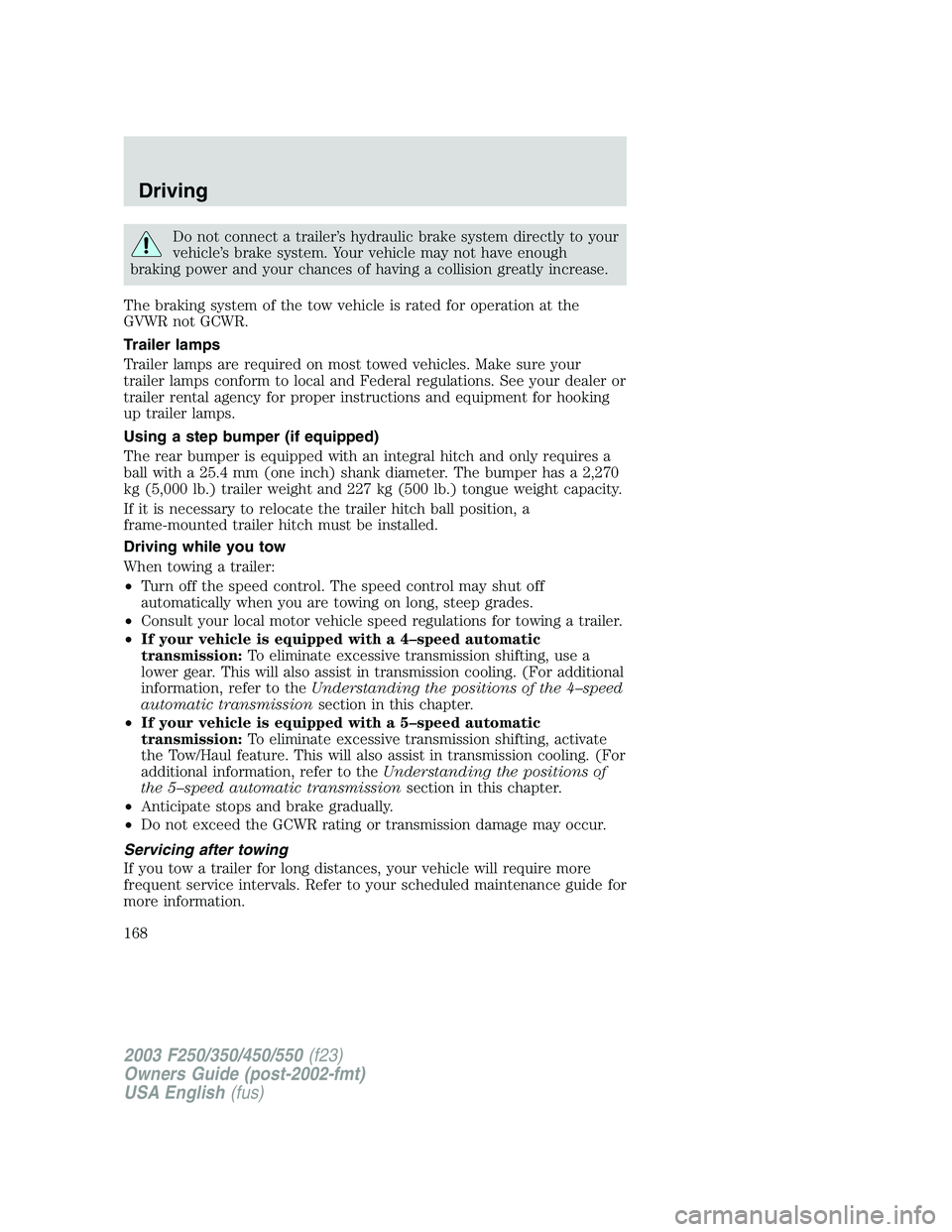
Do not connect a trailer’s hydraulic brake system directly to your
vehicle’s brake system. Your vehicle may not have enough
braking power and your chances of having a collision greatly increase.
The braking system of the tow vehicle is rated for operation at the
GVWR not GCWR.
Trailer lamps
Trailer lamps are required on most towed vehicles. Make sure your
trailer lamps conform to local and Federal regulations. See your dealer or
trailer rental agency for proper instructions and equipment for hooking
up trailer lamps.
Using a step bumper (if equipped)
The rear bumper is equipped with an integral hitch and only requires a
ball with a 25.4 mm (one inch) shank diameter. The bumper has a 2,270
kg (5,000 lb.) trailer weight and 227 kg (500 lb.) tongue weight capacity.
If it is necessary to relocate the trailer hitch ball position, a
frame-mounted trailer hitch must be installed.
Driving while you tow
When towing a trailer:
•Turn off the speed control. The speed control may shut off
automatically when you are towing on long, steep grades.
•Consult your local motor vehicle speed regulations for towing a trailer.
•If your vehicle is equipped with a 4–speed automatic
transmission:To eliminate excessive transmission shifting, use a
lower gear. This will also assist in transmission cooling. (For additional
information, refer to theUnderstanding the positions of the 4–speed
automatic transmissionsection in this chapter.
•If your vehicle is equipped with a 5–speed automatic
transmission:To eliminate excessive transmission shifting, activate
the Tow/Haul feature. This will also assist in transmission cooling. (For
additional information, refer to theUnderstanding the positions of
the 5–speed automatic transmissionsection in this chapter.
•Anticipate stops and brake gradually.
•Do not exceed the GCWR rating or transmission damage may occur.
Servicing after towing
If you tow a trailer for long distances, your vehicle will require more
frequent service intervals. Refer to your scheduled maintenance guide for
more information.
2003 F250/350/450/550(f23)
Owners Guide (post-2002-fmt)
USA English(fus)
Driving
168
Page 169 of 280
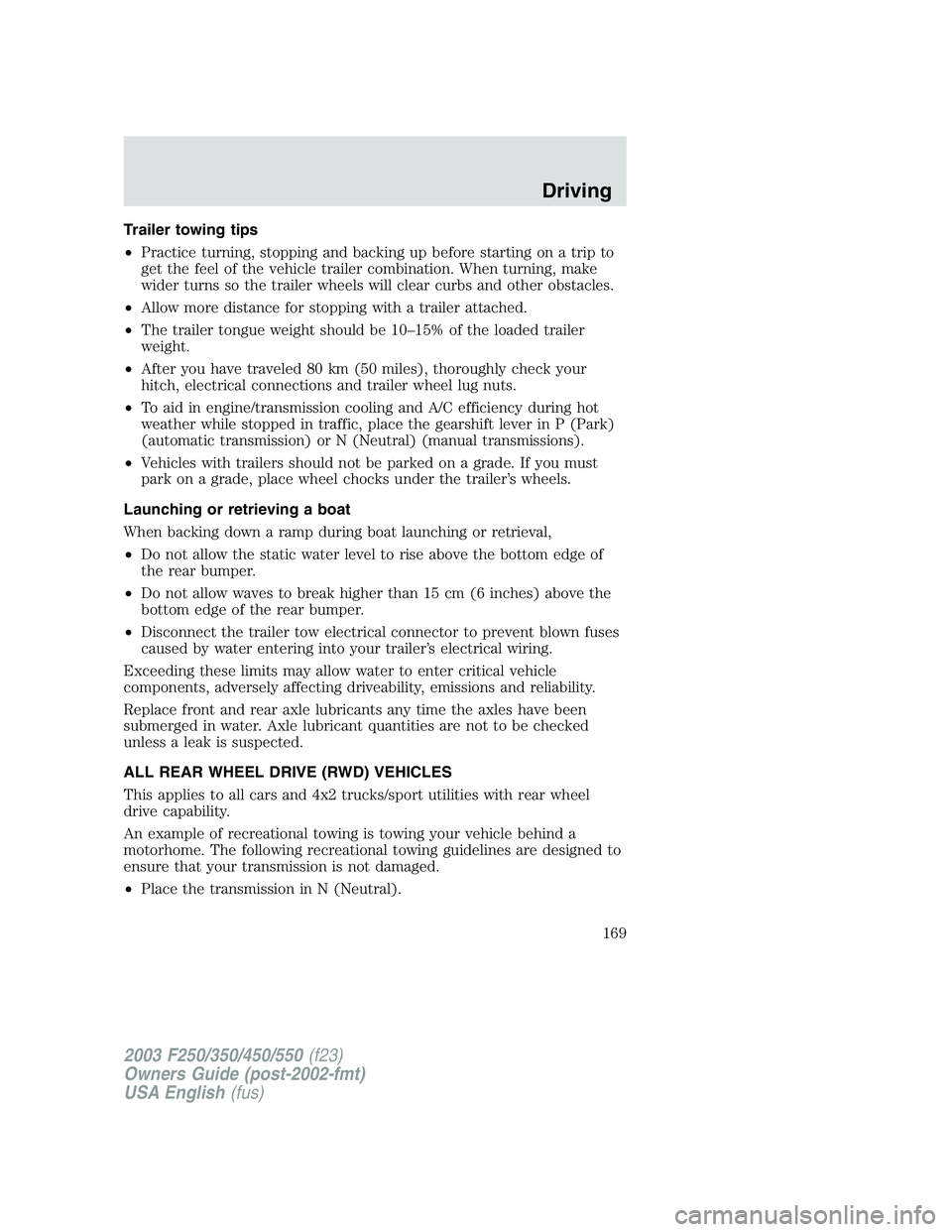
Trailer towing tips
•Practice turning, stopping and backing up before starting on a trip to
get the feel of the vehicle trailer combination. When turning, make
wider turns so the trailer wheels will clear curbs and other obstacles.
•Allow more distance for stopping with a trailer attached.
•The trailer tongue weight should be 10–15% of the loaded trailer
weight.
•After you have traveled 80 km (50 miles), thoroughly check your
hitch, electrical connections and trailer wheel lug nuts.
•To aid in engine/transmission cooling and A/C efficiency during hot
weather while stopped in traffic, place the gearshift lever in P (Park)
(automatic transmission) or N (Neutral) (manual transmissions).
•Vehicles with trailers should not be parked on a grade. If you must
park on a grade, place wheel chocks under the trailer’s wheels.
Launching or retrieving a boat
When backing down a ramp during boat launching or retrieval,
•Do not allow the static water level to rise above the bottom edge of
the rear bumper.
•Do not allow waves to break higher than 15 cm (6 inches) above the
bottom edge of the rear bumper.
•Disconnect the trailer tow electrical connector to prevent blown fuses
caused by water entering into your trailer’s electrical wiring.
Exceeding these limits may allow water to enter critical vehicle
components, adversely affecting driveability, emissions and reliability.
Replace front and rear axle lubricants any time the axles have been
submerged in water. Axle lubricant quantities are not to be checked
unless a leak is suspected.
ALL REAR WHEEL DRIVE (RWD) VEHICLES
This applies to all cars and 4x2 trucks/sport utilities with rear wheel
drive capability.
An example of recreational towing is towing your vehicle behind a
motorhome. The following recreational towing guidelines are designed to
ensure that your transmission is not damaged.
•Place the transmission in N (Neutral).
2003 F250/350/450/550(f23)
Owners Guide (post-2002-fmt)
USA English(fus)
Driving
169
Page 170 of 280

•Maximum speed is 56 km/h (35 mph).
•Maximum distance is 80 km (50 miles).
If a distance of 80 km (50 miles) or a speed of 56 km/h (35 mph) must
be exceeded, you must disconnect the driveshaft. Ford recommends the
driveshaft be removed/installed only by a qualified technician. See your
local dealer for driveshaft removal/installation.
Improper removal/installation of the driveshaft can cause
transmission fluid loss, damage to the driveshaft and internal
transmission components.
RWD vehicles with 4x4 electronic shift transfer case or All Wheel
Drive (AWD) vehicles with automatic transmissions:
Regarding recreational towing or having your vehicle towed, 4x4 vehicles
with electronic shift on the fly and AWD vehicles cannot be towed with
any wheels on the ground (with the exception of moving it as a disabled
vehicle off the road out of traffic).
SNOWPLOWING
Note:Do not use your vehicle to snowplow until it has been driven at
least 800 km (500 miles). Follow the severe duty schedule in your
scheduled maintenance guide for engine oil and transmission fluid
change intervals.
Note:Ford does not install snowplows.
For low speed snow removal, Ford offers a Snowplow Package Option on
select 4x4 vehicles. To assist Ford dealers and equipment installers
further prepare the vehicle for snowplowing, Ford includes instructions
in theFord Truck Body Builders Layout BookandFord Truck Source
Book. These instructions are available through your Ford dealer; they
include the list of vehicle models recommended for snowplowing and
snowplow weight limits. Use of the Snowplow Package Option, or its
equivalent, along with these instructions will help avoid possible
powertrain and chassis damage from snowplowing.
The front and rear GAWR, GVWR, Total Accessory Reserve Capacity
(TARC) and tire inflation pressures are found on the Safety Compliance
Certification Label located on one of the vehicle’s door jambs. This label
is applied to all vehicles completed by Ford Motor Company. Incomplete
vehicles built by Ford Motor Company will have an Incomplete Vehicle
Label in place of the Safety Compliance Label. The TARC does not apply
to Incomplete Vehicles and will not be shown on the Incomplete Vehicle
Label. The weight of the vehicle with occupants must never exceed the
front and rear GAWR or the GVWR.
2003 F250/350/450/550(f23)
Owners Guide (post-2002-fmt)
USA English(fus)
Driving
170